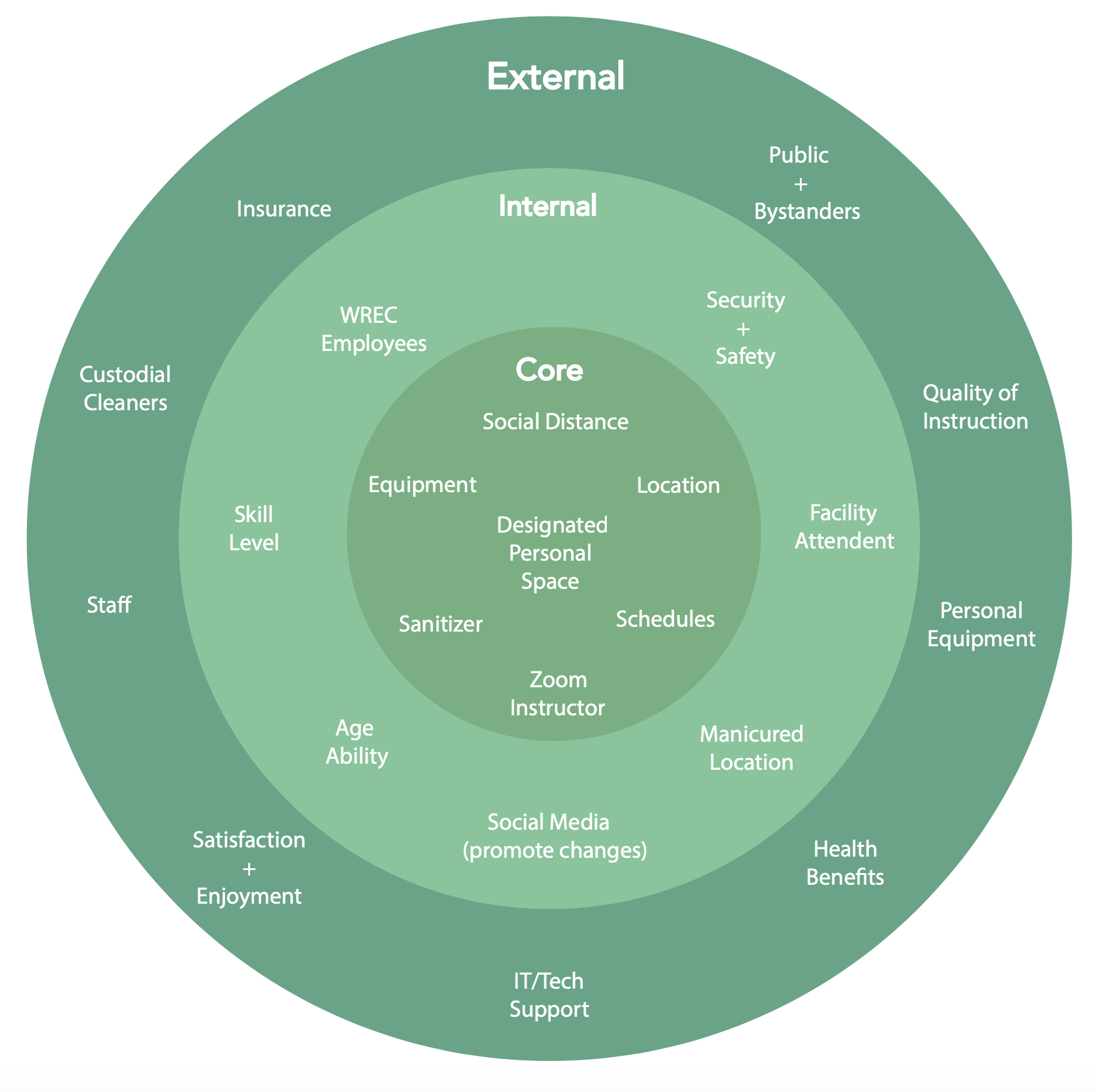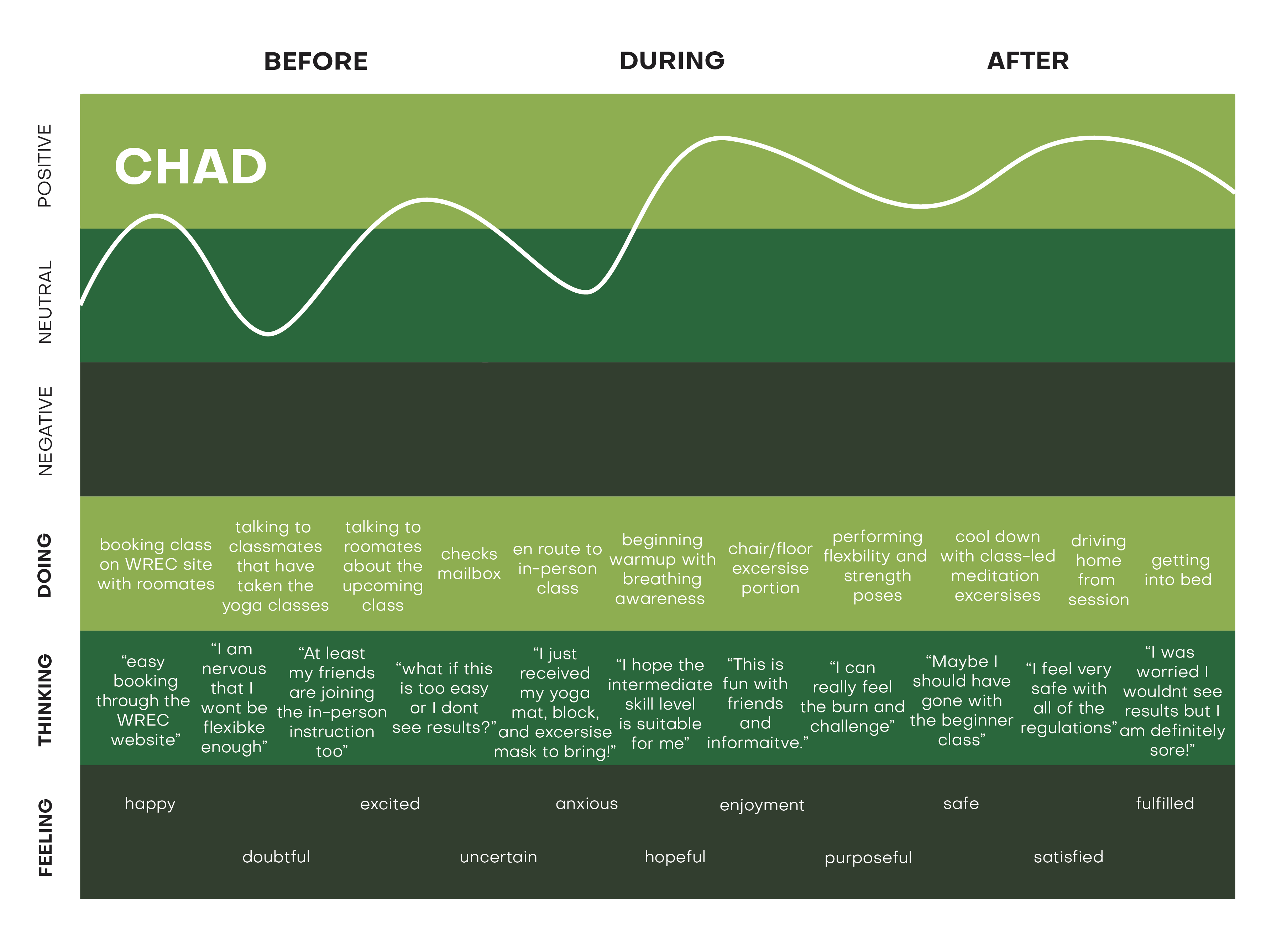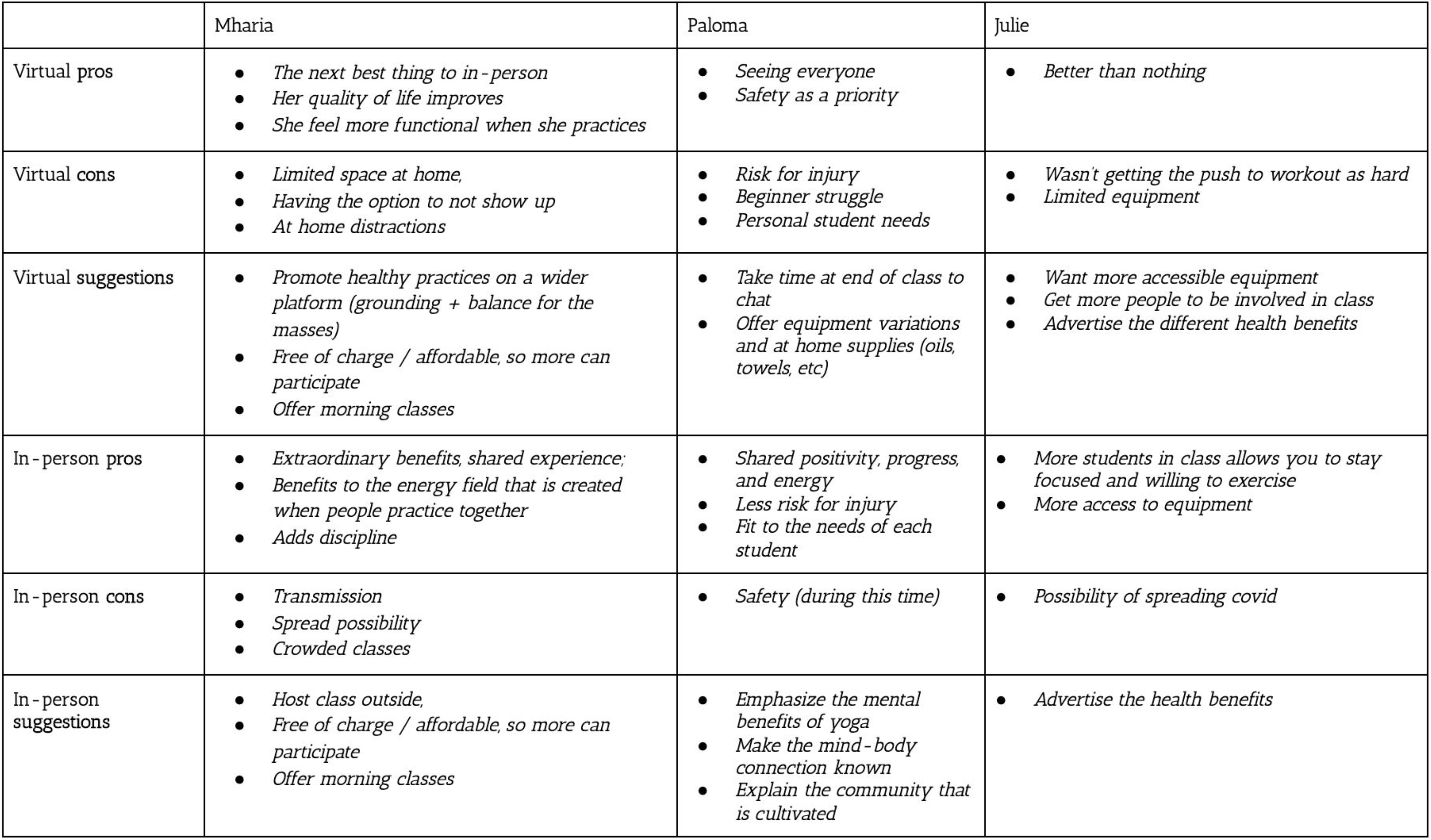WREC Yoga
Service Design
Duration
14 weeks
My Role
Mapping
Primary Research
Presenation
14 weeks
My Role
Mapping
Primary Research
Presenation
Team Members
Cory Hunter
Bronson Sannar
Ekiti Ross-Wallcott
Cory Hunter
Bronson Sannar
Ekiti Ross-Wallcott
Problem
Since the initial outbreak of Covid-19 in January of 2020, the world has experienced a year of great adversity and adaptation. As students, we know first-hand the extent in which our campus resources have been altered, specifically the Wildcat Recreation Center (WREC). We found it important to ensure a safe continuation of WREC provided yoga, not only to maintain a highly utilized campus resource for students and staff, but also to promote the mental and physical benefits induced by yoga practice in a time where the community needs it most.
Since the initial outbreak of Covid-19 in January of 2020, the world has experienced a year of great adversity and adaptation. As students, we know first-hand the extent in which our campus resources have been altered, specifically the Wildcat Recreation Center (WREC). We found it important to ensure a safe continuation of WREC provided yoga, not only to maintain a highly utilized campus resource for students and staff, but also to promote the mental and physical benefits induced by yoga practice in a time where the community needs it most.
Solution
Our final service design introduced remote WREC provided yoga classes accessible to students and staff in the safety of their own homes. Through the WREC website and Zoom platform, users can experience live instructor guided yoga sessions just as one would on campus. The online yoga service’s main features include varying class levels based on experience from beginner to advanced, modified classes for those with injuries or accommodation needs, and easy website navigation ensuring accurate class level registration and session times.
Our final service design introduced remote WREC provided yoga classes accessible to students and staff in the safety of their own homes. Through the WREC website and Zoom platform, users can experience live instructor guided yoga sessions just as one would on campus. The online yoga service’s main features include varying class levels based on experience from beginner to advanced, modified classes for those with injuries or accommodation needs, and easy website navigation ensuring accurate class level registration and session times.

Research Phase 1
Our first phase of research consisted of familiarizing ourselves with who and what exactly this service would affect. We organized our exploratory research through service mapping that established stakeholders, territories, customer identities, user journeys, and possible scenarios. These tools allowed our team to visualize the successful factors, as well as the pain points that may prevent a community member from utilizing the remote WREC Yoga service.
![Onion Map: Relationship of stakeholders to project goal]()
Our first phase of research consisted of familiarizing ourselves with who and what exactly this service would affect. We organized our exploratory research through service mapping that established stakeholders, territories, customer identities, user journeys, and possible scenarios. These tools allowed our team to visualize the successful factors, as well as the pain points that may prevent a community member from utilizing the remote WREC Yoga service.



Research Phase 2
What to research
What to research
-
How to operate a zoom or socially distanced yoga
class
-
The differences seen in protocol, class size, class
type variety, etc.
-
How can we improve the existing WREC provided
yoga classes?
-
How user friendly is the service as of right now?
-
What are the main concerns of the users?
Research tools
-
Interview avid yoga students and instructors
-
Web searching
-
Observing yoga sessions
-
Gathering information from users (Questionnaire)
Items + Individuals
-
Instructors
-
Yoga certification holders
-
Yoga students
- Students/staff
Primary Research
We found it important to take an ethnographic approach and reach out to individuals that would be utilizing the service, were familiar with existing forms, or could provide insight on yoga classes in general taking place both before and during the pandemic. We conducted a series of three interviews, asking questions to both students and certified instructors regarding the differences in remote yoga class quality, safety, and overall enjoyability. Our team also constructed a ten-question survey touching on similar topics, which was distributed to past and/or present students and instructors of WREC Yoga specifically. This was also shared with the University’s Kinesiology Department and interviewees.
Secondary Research
Our secondary research consisted of inquiring how other gyms, studios, and university’s were conducting similar services of remote yoga. We found multiple sources discussing the social and energetic differences of remote versus in-person sessions, most of which conducted their own interviews and surveys which relayed reliable and relevant information. Through our secondary research, we also discovered a source focusing on the pros and cons of teaching online yoga, which greatly benefitted our Service Blueprint in how instructors have adapted to teach remotely.
We found it important to take an ethnographic approach and reach out to individuals that would be utilizing the service, were familiar with existing forms, or could provide insight on yoga classes in general taking place both before and during the pandemic. We conducted a series of three interviews, asking questions to both students and certified instructors regarding the differences in remote yoga class quality, safety, and overall enjoyability. Our team also constructed a ten-question survey touching on similar topics, which was distributed to past and/or present students and instructors of WREC Yoga specifically. This was also shared with the University’s Kinesiology Department and interviewees.
Secondary Research
Our secondary research consisted of inquiring how other gyms, studios, and university’s were conducting similar services of remote yoga. We found multiple sources discussing the social and energetic differences of remote versus in-person sessions, most of which conducted their own interviews and surveys which relayed reliable and relevant information. Through our secondary research, we also discovered a source focusing on the pros and cons of teaching online yoga, which greatly benefitted our Service Blueprint in how instructors have adapted to teach remotely.

Findings
Through our research methods, we were able to confidently determine the successes and pain points in need of redesign within our service blueprint. We concluded that although in-person sessions are deeply missed, remote yoga can be an advantageous experience.
The most significant bottleneck retrieved from response data was the inability for instructors to physically monitor and assists students, especially those in need of modified poses.
We combatted this issue through the addition of a single staff member to monitor said students, the Zoom Chat, manage the technological portion, and alert the instructor if a student is in need of a specific accommodation. The addition of a single staff member will heighten the remote experience and decrease the potential for injury.

Challenges
There are many struggles to remote research and group work in general, which I would say attributed to most of our challenges over the course of the semester. Our biggest challenge was getting a hold of the University's yoga instructors. This goes for the Wildcat Recreation Center management, and the Kinesiology Department as well. This limited our human subject feedback from past and present users of the WREC’s Yoga classes, leaving it difficult to know the demands of customers. The pandemic also prevented our team to collaborate in person. Where platforms like Miro and group whiteboards suffice, getting hands on with some of our group work would have alleviated some challenges.
There are many struggles to remote research and group work in general, which I would say attributed to most of our challenges over the course of the semester. Our biggest challenge was getting a hold of the University's yoga instructors. This goes for the Wildcat Recreation Center management, and the Kinesiology Department as well. This limited our human subject feedback from past and present users of the WREC’s Yoga classes, leaving it difficult to know the demands of customers. The pandemic also prevented our team to collaborate in person. Where platforms like Miro and group whiteboards suffice, getting hands on with some of our group work would have alleviated some challenges.
Learnings
My biggest takeaway from this challenge is the power of ethnography, human based research, and how efficiently you can attain data from the masses in efforts to solve a problem. I learned the purpose of personas, territory maps, and service blueprints which all serve a huge purpose in ensuring a realistic and successful system. One thing I may have done differently was reach out to human-subject sources earlier in the semester to avoid initial bottlenecks. These learnings contribute to my understanding of service design in its entirety - something that was initially very difficult to define. I now understand what it means to provide a service. It is what you cannot see that assists its functionality, and you cannot work alone.
My biggest takeaway from this challenge is the power of ethnography, human based research, and how efficiently you can attain data from the masses in efforts to solve a problem. I learned the purpose of personas, territory maps, and service blueprints which all serve a huge purpose in ensuring a realistic and successful system. One thing I may have done differently was reach out to human-subject sources earlier in the semester to avoid initial bottlenecks. These learnings contribute to my understanding of service design in its entirety - something that was initially very difficult to define. I now understand what it means to provide a service. It is what you cannot see that assists its functionality, and you cannot work alone.

